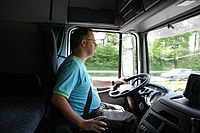
Photo from wikipedia
Driver sleepiness constitutes a well-known traffic safety risk. With the introduction of automated driving systems, the chance of getting sleepy and even falling asleep at wheel could increase further. Conventional… Click to show full abstract
Driver sleepiness constitutes a well-known traffic safety risk. With the introduction of automated driving systems, the chance of getting sleepy and even falling asleep at wheel could increase further. Conventional sleepiness detection methods based on driving performance and behavior may not be available under automated driving. Methods based on physiological measurements such as heart rate variability (HRV) becomes a potential solution under automated driving. However, with reduced task load, HRV could potentially be affected by automated driving. Therefore, it is essential to investigate the influence of automated driving on the relation between HRV and sleepiness. Data from real-road driving experiments with 43 participants were used in this study. Each driver finished four trials with manual and partial automated driving under normal and sleep-deprived condition. Heart rate was monitored by consumer wearable chest bands. Subjective sleepiness based on Karolinska sleepiness scale was reported at five min interval as ground truth. Reduced heart rate and increased overall variability were found in association with severe sleepy episodes. A binary classifier based on the AdaBoost method was developed to classify alert and sleepy episodes. The results indicate that partial automated driving has small impact on the relationship between HRV and sleepiness. The classifier using HRV features reached area under curve (AUC) = 0.76 and it was improved to AUC = 0.88 when adding driving time and day/night information. The results show that commercial wearable heart rate monitor has the potential to become a useful tool to assess driver sleepiness under manual and partial automated driving.
Journal Title: IEEE Transactions on Intelligent Transportation Systems
Year Published: 2022
Link to full text (if available)
Share on Social Media: Sign Up to like & get
recommendations!